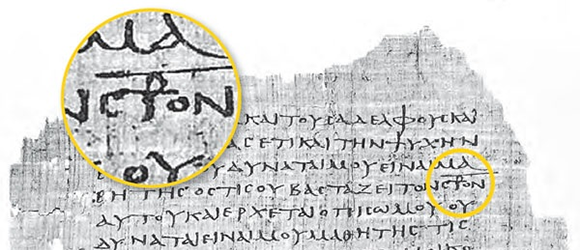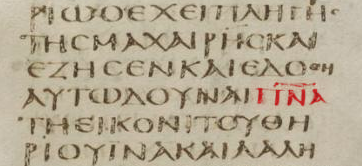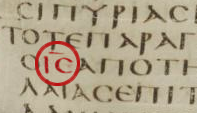It looks like you're using an Ad Blocker.
Please white-list or disable AboveTopSecret.com in your ad-blocking tool.
Thank you.
Some features of ATS will be disabled while you continue to use an ad-blocker.
6
share:

Lately, while doing research into the different readings of the number of the beast, and sifting through what I've found on the net relating to the old manuscripts in question— I was made aware of a few interesting things relating to early Christianity and Koine Greek in particular. For instance, when numbers are written within Greek NT documents, they are rendered as letters (with given numerical values, i.e. Gr. «Isopsephy» the counterpart of Heb. «Gematria») with streaks above them. But when I dug further, I found that the early Christian scribes and copyists used these streaks above far more letters than just numbers. That was when I discovered the Latin term «Nomina Sacra» or «Names Sacred» (or rather «Sacred Names»). Apparently the early scribes often abbreviated certain names and nouns relating to the divine, like in the icon from Hagia Sophia above, where Gr. «ΙΣ» and «ΧΣ» replace Gr. «Ἰησοῦς Χριστός» i.e. «Jesus Christ.» According to Wikipedia— A nomen sacrum consists of two or more letters from the original word spanned by an overline.[sic.]
The rule seems to be to use at least the first and last letters in the name (confer with the concept of «the first and the last» and «the Alpha and the Omega»)— and they would typically reflect the given kasus and numerus. For instance «God» or Gr. nom. «Theos» would read Gr. «ΘΣ» in nominative, but «ΘΥ» in genitive, as in Gr. «Theou.» The below picture shows text from the opening chapter of the Gospel of John, as rendered in the Codex Vaticanus (early 4th century LXX+NT). The letters «ΙΥ» (iota-upsilon) and «ΘΥ» (theta-upsilon)— with overlines— is used to abbreviate «Jesus» and «God» respectively, here, both in genitive forms, as in Gr. «Ἰησοῦ» (Gr. gen. «Iesou» «Jesus'») and θεοῦ (Gr. gen. «Theou» «God's»):

And here is the pic which first kindled this brief study of mine into Greek letter codes in NT Greek documents, the p115:

At first glimpse I didn't straight away understand why the text included these overlines, let alone the concept of «nomina sacra», but my curiosity was ignited, and after doing the actual reading of the overlined texts, it became quite clear that we were talking about yet another oddity— even compared to the odd world of nomina sacra itself: In p115, basically a fragment from Revelation, where the number of the beast is written as 616— there is one such «nomen sacrum» just above where 616 is written, and the word abbreviated is Gr. «Anthropou» (abbreviated «ANOY») which means «a man's». This particular abbreviation is only used in papyri with a more generous use of these abbreviations, such as the p47, p66, p75, so back when p115 was complete, it was most likely a document demonstrating abundant use of such abbreviations or «nomina sacra.»
Here you can see a list of these «nomina sacra» from the first few centuries' Greek NT documents: en.wikipedia.org...
Normally these shorthand abbreviations reflect some sort of divine reverence, much like how the Tetragrammaton in the OT would be replaced by LORD or Adonai or similar, only in abbreviated form, though some such manuscripts seem to be more generous with these contractions, and belong more in the category of ligatures like how medieval monks would substitute certain frequently occurring prepositions and syllables like using a simple «&» instead of Lat. «et» and «@» instead of Lat. «ad» and so on, there are quite a few in use still today. The NT Greek copyists working in the first few centuries AD also used many such ligatures. I suspect many of you are familiar with the Chi-Rho:
This is X (chi) with a P (rho) superimposed. In Greek X and P are the first two letters in Gr. Χριστός («Christos»). A similar such ligature is found in the early third century NT Greek manuscript called Papyrus 75, abbreviated p75, or referred to as Papyrus Bodmer XIV-XV. In Luke 14:27 the word «Stauros» or «Cross» is replaced with a «Tau-Rho»— a Staurogram — see en.wikipedia.org... for more such ligatures and symbols:

Pics from Wikipedia. Red letters added by me.
ETA: Links:
Nomina sacra => en.wikipedia.org...
Codex Vaticanus => en.wikipedia.org...
Ligatures => en.wikipedia.org...
Chi-Rho => en.wikipedia.org...
Papyrus 75 => en.wikipedia.org...
Christian symbolism => en.wikipedia.org...
edit on 21-8-2015 by Utnapisjtim because: syntax, misc + ETA + corr.
link
originally posted by: Utnapisjtim
I had seen but never associated any significance to the over-line except to assume that it meant the same as an underline in English - an emphasis.
I still think it could be that, but you have given me some food for thought. Thanks.
edit on 21/8/2015 by chr0naut because: (no reason given)
a reply to: chr0naut
Apparently the overline means that the given word is not a regular word, so an emphasis yes, but not just any emphasis it turns out. They use these lines above numbers nomina sacra and special characters like the Staurogram I showed in the OP. And there's plenty of these overlines in the old manuscripts. Below is a list of such nomina sacra (n.s.):
God (English) Θεός (Greek) ΘΣ (n.s. nom.) ΘΥ (n.s. gen.)
Lord Κύριος ΚΣ ΚΥ
Jesus Ἰησοῦς ΙΣ ΙΥ
Christ/Messiah Χριστός ΧΣ ΧΥ
Son Υἱός ΥΣ ΥΥ
Spirit/Ghost Πνεῦμα ΠΝΑ ΠΝΣ
David Δαυὶδ ΔΑΔ
Cross/Stake Σταυρός ΣΤΣ ΣΤΥ
Mother Μήτηρ ΜΗΡ ΜΗΣ
God Bearer i.e. Mother of God Θεοτόκος ΘΚΣ ΘΚΥ
Father Πατήρ ΠΗΡ ΠΡΣ
Israel Ἰσραήλ ΙΗΛ
Savior Σωτήρ ΣΗΡ ΣΡΣ
Human being/Man Ἄνθρωπος ΑΝΟΣ ΑΝΟΥ
Jerusalem Ἱερουσαλήμ ΙΛΗΜ
Heaven/Heavens Οὐρανός ΟΥΝΟΣ ΟΥΝΟΥ
Source: en.wikipedia.org...
ETA: Another, similar word is the Greek word «ΙΧΘΥΣ» or «Ichtys» which means Fish, but to the early Christians it was an acronym for «Ἰησοῦς Χριστός, Θεοῦ Υἱός, Σωτήρ» (Iesous Khristos, Theou hyios, soter) which means «Jesus Christ, God's Son, Saviour.»
See more at en.wikipedia.org...
ETA2: Also, I found a great page with a indexable online facsimile of the Codex Sinaiticus => codexsinaiticus.org... => AND I found another example of shortening Anthropos (human being) into ανου or ANOY. Red emphasis by me:

And here's another, word is ∏NA shortened from Gr. «Pnauma» - «spirit»

And below you can see the striked out word «ous» corrected to be replaced by «noun» (right margin, not the edit tag). Quite funny, we do it exactly the same way these days:

Apparently the overline means that the given word is not a regular word, so an emphasis yes, but not just any emphasis it turns out. They use these lines above numbers nomina sacra and special characters like the Staurogram I showed in the OP. And there's plenty of these overlines in the old manuscripts. Below is a list of such nomina sacra (n.s.):
God (English) Θεός (Greek) ΘΣ (n.s. nom.) ΘΥ (n.s. gen.)
Lord Κύριος ΚΣ ΚΥ
Jesus Ἰησοῦς ΙΣ ΙΥ
Christ/Messiah Χριστός ΧΣ ΧΥ
Son Υἱός ΥΣ ΥΥ
Spirit/Ghost Πνεῦμα ΠΝΑ ΠΝΣ
David Δαυὶδ ΔΑΔ
Cross/Stake Σταυρός ΣΤΣ ΣΤΥ
Mother Μήτηρ ΜΗΡ ΜΗΣ
God Bearer i.e. Mother of God Θεοτόκος ΘΚΣ ΘΚΥ
Father Πατήρ ΠΗΡ ΠΡΣ
Israel Ἰσραήλ ΙΗΛ
Savior Σωτήρ ΣΗΡ ΣΡΣ
Human being/Man Ἄνθρωπος ΑΝΟΣ ΑΝΟΥ
Jerusalem Ἱερουσαλήμ ΙΛΗΜ
Heaven/Heavens Οὐρανός ΟΥΝΟΣ ΟΥΝΟΥ
Source: en.wikipedia.org...
ETA: Another, similar word is the Greek word «ΙΧΘΥΣ» or «Ichtys» which means Fish, but to the early Christians it was an acronym for «Ἰησοῦς Χριστός, Θεοῦ Υἱός, Σωτήρ» (Iesous Khristos, Theou hyios, soter) which means «Jesus Christ, God's Son, Saviour.»
See more at en.wikipedia.org...
edit on 22-8-2015 by Utnapisjtim because: list + eta + shortened + eta-link
ETA2: Also, I found a great page with a indexable online facsimile of the Codex Sinaiticus => codexsinaiticus.org... => AND I found another example of shortening Anthropos (human being) into ανου or ANOY. Red emphasis by me:

And here's another, word is ∏NA shortened from Gr. «Pnauma» - «spirit»

And below you can see the striked out word «ous» corrected to be replaced by «noun» (right margin, not the edit tag). Quite funny, we do it exactly the same way these days:

edit on 22-8-2015 by Utnapisjtim because: eta2
a reply to: Utnapisjtim
And here is why you shouldn't call ISIL for IS, we should use the Arab acronym DAESH(?) instead:

Red text in Greek reads IS and is nomen sacrum shorthand for IesouS. That is Jesus.
Instead of ISIL, ISIS and IS we should rather use the Arabic term for the present Salafist terrorist wannabe caliphate instead I think: DAESH according to Wikipedia. داعش in Arabic (can someone verify this?) source: en.wikipedia.org...
And here is why you shouldn't call ISIL for IS, we should use the Arab acronym DAESH(?) instead:

Red text in Greek reads IS and is nomen sacrum shorthand for IesouS. That is Jesus.
Instead of ISIL, ISIS and IS we should rather use the Arabic term for the present Salafist terrorist wannabe caliphate instead I think: DAESH according to Wikipedia. داعش in Arabic (can someone verify this?) source: en.wikipedia.org...
edit on 22-8-2015 by Utnapisjtim because: (no reason given)
new topics
-
The Premonition of Ella Mae Bowles
Paranormal Studies: 1 hours ago -
Ron DeSantis endorses 'deadly force' against migrants suspected of trafficking drugs
US Political Madness: 2 hours ago -
I'm convinced...now more than ever
General Conspiracies: 2 hours ago -
CIA Corruption, Killer Drones, and Government Surveillance
Weaponry: 2 hours ago -
Biden administration authorized 'Use of Deadly Force' in Mar-a-Lago raid
US Political Madness: 3 hours ago -
Gunsmith Sentenced to Prison For Legal Firearm Told: “The Second Amendment Doesn’t Exist in My C
Breaking Alternative News: 8 hours ago -
Our country is now a joke: congress members bickering.
Jokes, Puns, & Pranks: 10 hours ago -
The Committee of 300 and the Tavistock Institute
New World Order: 10 hours ago -
Scientists to install nuclear-powered UFO detectors in space to lure aliens to Earth
Aliens and UFOs: 10 hours ago -
Big Fani Willis Calls Prosecutorial Oversight Board "Racist"
US Political Madness: 11 hours ago
top topics
-
Gunsmith Sentenced to Prison For Legal Firearm Told: “The Second Amendment Doesn’t Exist in My C
Breaking Alternative News: 8 hours ago, 20 flags -
I'm convinced...now more than ever
General Conspiracies: 2 hours ago, 16 flags -
Big Fani Willis Calls Prosecutorial Oversight Board "Racist"
US Political Madness: 11 hours ago, 15 flags -
Biden administration authorized 'Use of Deadly Force' in Mar-a-Lago raid
US Political Madness: 3 hours ago, 12 flags -
Ron DeSantis endorses 'deadly force' against migrants suspected of trafficking drugs
US Political Madness: 2 hours ago, 6 flags -
The Committee of 300 and the Tavistock Institute
New World Order: 10 hours ago, 5 flags -
Scientists to install nuclear-powered UFO detectors in space to lure aliens to Earth
Aliens and UFOs: 10 hours ago, 4 flags -
CIA Corruption, Killer Drones, and Government Surveillance
Weaponry: 2 hours ago, 3 flags -
The Premonition of Ella Mae Bowles
Paranormal Studies: 1 hours ago, 3 flags -
Our country is now a joke: congress members bickering.
Jokes, Puns, & Pranks: 10 hours ago, 2 flags
6


